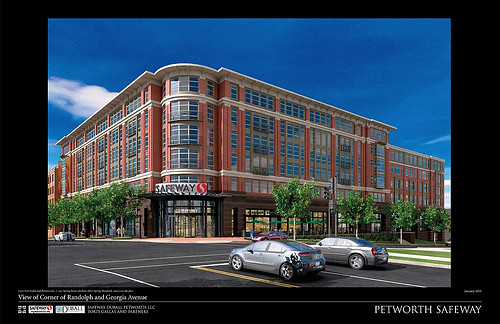Chasing Wegman's is a bad idea for DC
The Washington Business Journal, reporting on DC's foray at this year's retail recruitment conference, the ICSC show in Las Vegas, reports in "Vincent Gray keeps hope alive for Wegmans in D.C." that DC is avidly recruiting Wegmans, the massive, high quality supermarket chain based in Rochester, NY that has been steadily entering the Washington and Baltimore markets with very large stores in the suburbs, for sites at St. Elizabeths in Southeast and the recently vacated Walter Reed Hospital Center on Georgia Avenue in upper Northwest.
Hey, I like cool grocery stores as much as anybody. For example, the premium Whole Foods Supermarket stores are pretty cool (there aren't any in the DC region), with lots of restaurant type operations within the store, and they even sell clothing. Wegmans takes that type of store to another level, with indoor seating for more than 300 people, and many "store within a store" specialty areas for cheese, meats, beer and wine, etc.
But Wegmans is a store designed for shoppers arriving by car. It's a big store, as much as 150,000 s.f., set in a sea of parking.
DC is a city. Automobile-focused retail is hard to accommodate, because the road network was designed, for the most part, in 1791. (Roads in upper Northwest and Southeast were designed later, but using the same general design, especially for road width.)
While freeways were added, the queuing area of a typical block is 300 feet, which accommodates about 20 cars/lane. Adding thousands and thousands of daily car trips to the city's roads is generally a bad idea.
While some retailers, including Target, Walmart (not so much for their DC stores), and others, are developing urban formats (see "Size Matters in Retail -- But Just What Size?" from Advertising Age), according to the WBJ story, Wegmans "does not have a smaller, more urban format similar to ones other retailers such as Wal-Mart have been trying out."
DC should know what it stands for. The city's new sustainability plan calls for 75% of household trips to be performed by modes other than the car.

A typical Wegmans. Image from Fairydreams.net.
In other words, the decisions of the city government should be congruent across the board.
How about approaching Wegmans and working with them to launch a truly urban-appropriate grocery store, including delivery (something I pushed the city to do with regard to Walmart's entry, and they totally wimped out)?
If they aren't willing, don't recruit them. It's not worth it. We shouldn't change what we are. They should either want to be active in our market on urban-appropriate terms, or not. If not, fine. Let's move on.
DC should continue to work with grocery stores like Harris-Teeter and Safeway, which are committed to doing stores more appropriately sized and fitted for the urban environment--even if I think they could do much better still (see my op-ed, "Temper Walmart glee with planning" in the Washington Business Journal).
It's bad enough that DC rolled over in every possible way for Walmart, not pushing Walmart to do much of anything in the way of urban design and appropriateness--the places where Walmart is building more urban-appropriate stores, two out of the six locations, is more a function of one developer, JBG, and the fact that they recruited Walmart to be a lead retail tenant in an otherwise mixed use, multistory building. The other four locations will be, for all intents and purposes, suburban stores, but with structured parking.
DC shouldn't further this bad mistake by recruiting other decidedly anti-urban retailers.
Ironically, Safeway intends to expand their Petworth store as the ground floor tenant of an apartment building. And they would likely do the same, eventually, at their Piney Branch store, also located on Georgia Avenue, but located about halfway between Walmart and the desired Wegmans. These are pro-urban decisions.
Recruiting Wegmans to Georgia Avenue, after Walmart enters in 2013, likely dooms these efforts, and says f* you to a company that has been invested in DC for more than 80 years.

Petworth Safeway rendering, which shows a multistory apartment building above the store.

The rendering of the Walmart Georgia Avenue store shows a single building on a 4+ acre site. The design of the store makes no accommodation for adding housing or other uses to the building and site.
Labels: big box retail ordinances, commercial district revitalization planning, formula retail, real estate development, urban design/placemaking, urban revitalization



0 Comments:
Post a Comment
<< Home